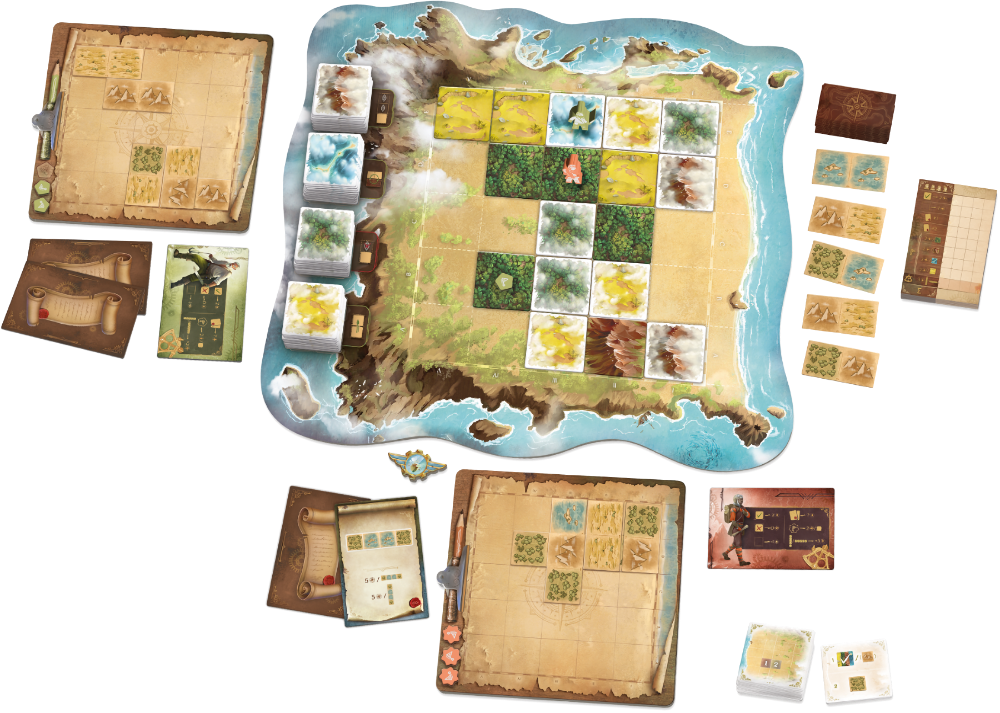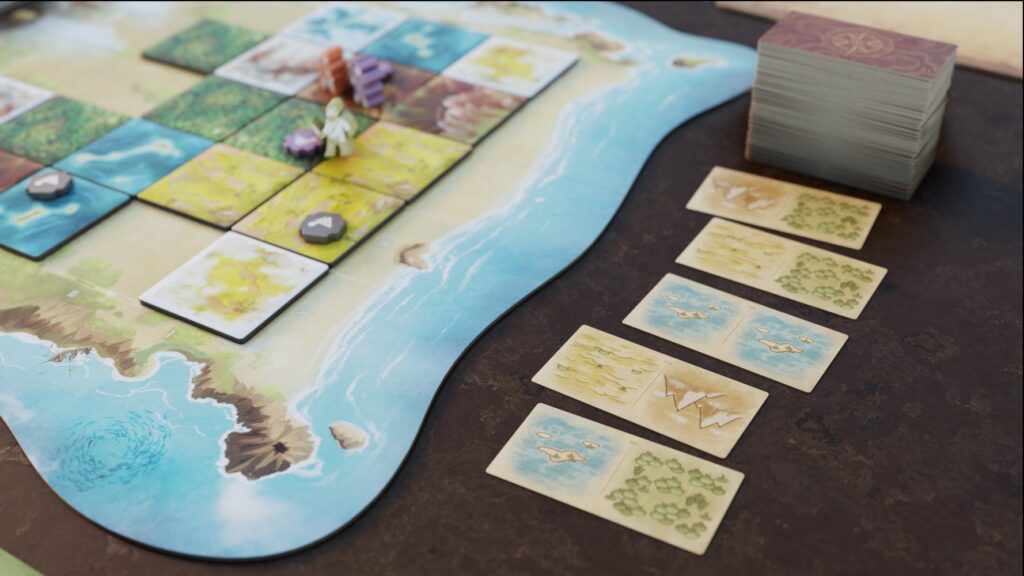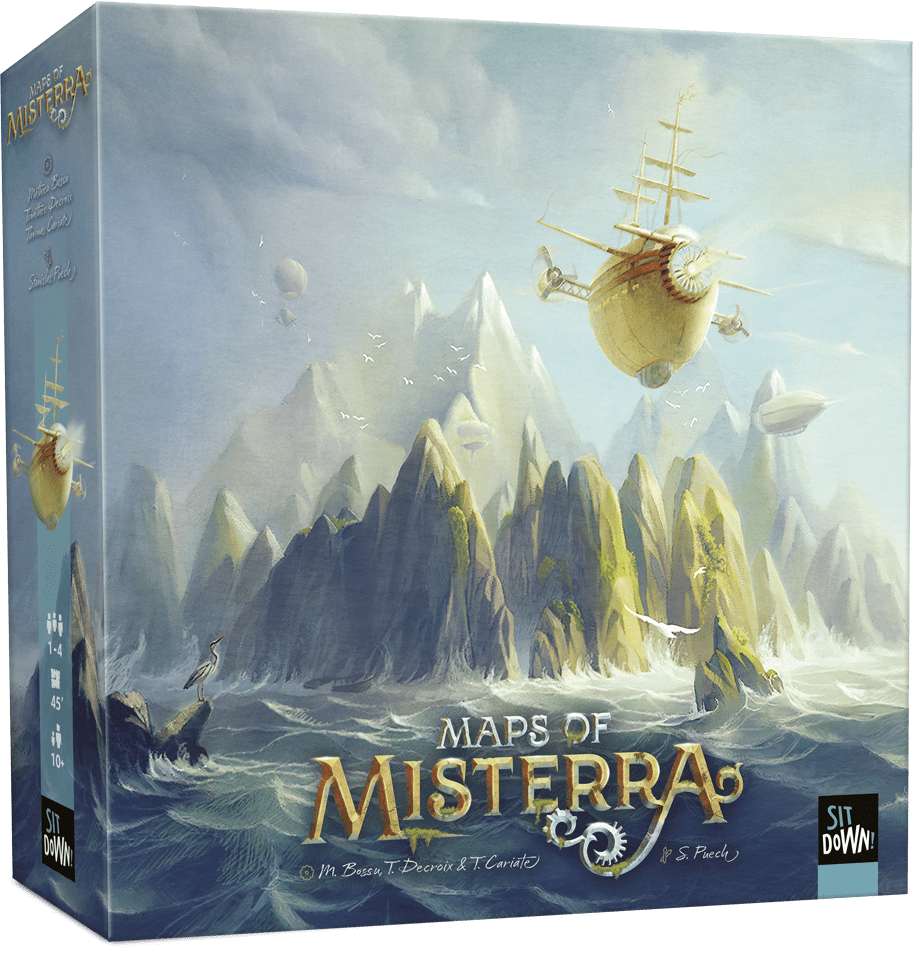You are tasked with mapping a completely unknown island. Will you conform to the reality on the ground or to the needs of your sponsor? This is all the subtlety of Maps of Misterraour board game of the week.
What is a board game? Maps of Misterra ?
Misterra, a completely unknown island, has just been discovered. The most enterprising scientific minds mount expeditions to map this new land. Will you be able to remain faithful to the reality on the ground or will you be more inclined to go in the direction of your sponsor’s hypotheses?
Accessible from 10 years old, for 1 to 4 players and games of around 45 minutes, it is a game of tile placement and majority which requires a little mental gymnastics to fully understand it. And this is also what makes it original.
Published by Sit Down, Maps of Misterra is a game by Mathieu Bossu, Thomas Cariate and Timothée Decroix, illustrated by Stanislas Puech, and sold at the price of €33.95 at Philibert.
How do you play it?
The island has just been discovered, the central board which represents it, divided into squares, is almost blank at the start of the game. It is up to you, the cartographers, to determine the terrain that covers it during your expeditions.

For this purpose, each player has a parchment board, with the same configuration as the central board, and a pawn of their color which travels around the island.
On your turn, you perform three actions. You start by moving your character one space, if you wish, to advance in exploring the area. At the start of the game, everyone must arrive on the island from the same side, the beach.
We then choose a sketch card from the five proposed. These sketches represent two types of terrain (steppe, jungle, lagoon or mountain), a bit like dominoes.
Then, we place this sketch on our personal parchment, depending on where our pawn is located. At the same time, tiles of the same type are placed on the central board, on the island.
These tiles have two sides: on one side, the “normal” terrain (jungle, mountain, etc.), and on the other the same terrain, but with mist.
Indeed, the first time a player maps a square, it is only a guess. The same square must be mapped a second time, with the same type of terrain, by anyone, for the area to be confirmed. We then turn the tile from the foggy side to its normal side.
The same zone can thus pass from one type of terrain to another, several times in the game, as long as there has been no confirmation.


We don’t choose sketches at random. At the start of the game, each player receives two objective cards. They represent what your sponsor would like to find on the island. It’s up to you to ensure that the “reality” of the island best reflects the wishes of your mission, to score as many points as possible at the end of the game. Obviously, the objectives of some are generally in opposition to those of others.
Players take turns until the island is completely mapped. We then score points according to our objectives, but also if our parchment corresponds to the reality of the island: the more squares we have in common, the more points we score.
Added to this are a few additional rules, including powers depending on the type of terrain your character is on. The mountain allows you to see further, and therefore to map the terrain one more space. The dense forest prevents you from mapping. Etc.
Why play Maps of Misterra ?
Let’s start by saluting the publishing quality of the game. The illustrations are very beautiful, the material is very well made. Tiles, boards, pawns in various shapes. Only small hiccup: a slight problem in the arrangement of the wedges in the box, which prevents optimizing the storage of the equipment. But that’s a detail.
Form does not make a game. What about substance?


From this point of view, Maps of Misterra is an excellent surprise. Despite the ultimately very simple rules (I move my pawn, then I place a sketch and the corresponding tiles on the boards), the gameplay is deeper and more subtle than one might imagine at first glance.
Because all the interest and originality of the game rest on this little twist, both thematic and mechanical, of the double validation necessary to confirm the typology of a terrain. It’s really clever and very intelligent.


On the other hand, the fact that you have to play on two boards at the same time (your own and the central island), requires a little mental gymnastics which may put off some. If you have difficulty with the representation in space, skip your turn, you risk getting knots in your brain.
There is no direct interaction in the game, you cannot influence another player’s board. But the choices of some on the central island have a significant impact on the results of others. This is especially true as the number of players increases.
Inevitably, the game is most tactical with two players. With four players, the progress is much more unpredictable, as the configuration of the island may have changed when your turn comes. Ultimately, it is the three-player configuration that we prefer and that we recommend, which offers the best compromise between tactics and chaos.
In addition to its very nice equipment, Maps of Misterraoffers a gameplayoriginal and clever, what’s more, it’s totally on theme. It’s a kind of big optimization puzzle, where other people’s choices have big impacts on yours. We strongly recommend that you try it, unless you really have difficulty representing in space.
In short
We liked
- A truly original, intelligent, and very thematic mechanic
- The reality on the ground vs. the desires of sponsors
- Double validation to confirm land
- Top equipment
We liked less
- Requires a certain amount of cerebral gymnastics which can be confusing
- A lot of handling on the sets, sometimes a little delicate
If you liked this article, you will like the following: don’t miss them by subscribing to Numerama on Google News.
Some links in this article are affiliated. We’ll explaine everything here.
